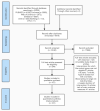Interventions for reducing blood pressure in prehypertension: A meta-analysis
- PMID: 37033077
- PMCID: PMC10078829
- DOI: 10.3389/fpubh.2023.1139617
Interventions for reducing blood pressure in prehypertension: A meta-analysis
Abstract
Background: We aimed to address which interventions best control blood pressure (BP) and delay disease progression in prehypertension and to give recommendations for the best option following a quality rating.
Methods: A Bayesian network meta-analysis was used to assess the effect of the intervention on BP reduction, delaying hypertension progression and final outcome, with subgroup analyses for time and ethnicity. Recommendations for interventions were finally based on cumulative ranking probabilities and CINeMA.
Results: From 22,559 relevant articles, 101 eligible randomized controlled trial articles (20,176 prehypertensive subjects) were included and 30 pharmacological and non-pharmacological interventions were evaluated. Moderate-quality evidence demonstrated that angiotensin II receptor blockers, aerobic exercise (AE), and dietary approaches to stop hypertension (DASH) lowered systolic blood pressure (SBP). For lowering diastolic blood pressure (DBP), AE combined with resistance exercise (RE) or AE alone provided high quality evidence, with calcium channel blockers, lifestyle modification (LSM) combined with drug providing moderate quality evidence. LSM produced the best BP lowering effect at 12 months and beyond of intervention. In Asians, TCD bubble was moderate quality evidence for lowering SBP and RE may have had a BP lowering effect in Caucasians. No recommendation can be given for delaying the progression of hypertension and reducing mortality outcomes because of low to very low quality of evidence.
Conclusion: AE combined RE are preferentially recommended for BP control in prehypertension, followed by DASH. Long-term BP control is preferred to LSM. Asians and Caucasians add TCD bubble and RE to this list as potentially effective interventions.
Systematic review registration: https://www.crd.york.ac.uk/prospero/display_record.php?ID=CRD42022356302, identifier: CRD42022356302.
Keywords: aerobic exercise; dietary approaches to stop hypertension (DASH); hypertension; meta-analysis; prehypertension.
Copyright © 2023 Li, Liu, Wang, Liu, Xiao, Wang and Wu.
Conflict of interest statement
The authors declare that the research was conducted in the absence of any commercial or financial relationships that could be construed as a potential conflict of interest.
Figures


Similar articles
-
Drugs for preventing postoperative nausea and vomiting in adults after general anaesthesia: a network meta-analysis.Cochrane Database Syst Rev. 2020 Oct 19;10(10):CD012859. doi: 10.1002/14651858.CD012859.pub2. Cochrane Database Syst Rev. 2020. PMID: 33075160 Free PMC article.
-
Falls prevention interventions for community-dwelling older adults: systematic review and meta-analysis of benefits, harms, and patient values and preferences.Syst Rev. 2024 Nov 26;13(1):289. doi: 10.1186/s13643-024-02681-3. Syst Rev. 2024. PMID: 39593159 Free PMC article.
-
Dietary Approaches to Stop Hypertension (DASH) for the primary and secondary prevention of cardiovascular diseases.Cochrane Database Syst Rev. 2025 May 6;5(5):CD013729. doi: 10.1002/14651858.CD013729.pub2. Cochrane Database Syst Rev. 2025. PMID: 40326569 Review.
-
Systemic pharmacological treatments for chronic plaque psoriasis: a network meta-analysis.Cochrane Database Syst Rev. 2021 Apr 19;4(4):CD011535. doi: 10.1002/14651858.CD011535.pub4. Cochrane Database Syst Rev. 2021. Update in: Cochrane Database Syst Rev. 2022 May 23;5:CD011535. doi: 10.1002/14651858.CD011535.pub5. PMID: 33871055 Free PMC article. Updated.
-
Systemic pharmacological treatments for chronic plaque psoriasis: a network meta-analysis.Cochrane Database Syst Rev. 2017 Dec 22;12(12):CD011535. doi: 10.1002/14651858.CD011535.pub2. Cochrane Database Syst Rev. 2017. Update in: Cochrane Database Syst Rev. 2020 Jan 9;1:CD011535. doi: 10.1002/14651858.CD011535.pub3. PMID: 29271481 Free PMC article. Updated.
Cited by
-
Detraining and Retraining Effects from a Multicomponent Training Program on the Functional Capacity and Health Profile of Physically Active Prehypertensive Older Women.Healthcare (Basel). 2024 Jan 21;12(2):271. doi: 10.3390/healthcare12020271. Healthcare (Basel). 2024. PMID: 38275551 Free PMC article.
-
Comparative effectiveness of lifestyle interventions for prehypertension: A network meta-analysis of randomized controlled trials.Am J Prev Cardiol. 2025 Jun 21;23:101045. doi: 10.1016/j.ajpc.2025.101045. eCollection 2025 Sep. Am J Prev Cardiol. 2025. PMID: 40677277 Free PMC article.
-
Effects of different exercise modalities on blood pressure and endothelial function in prehypertension individuals: a systematic review and network meta-analysis.Front Cardiovasc Med. 2025 Jun 25;12:1550435. doi: 10.3389/fcvm.2025.1550435. eCollection 2025. Front Cardiovasc Med. 2025. PMID: 40636824 Free PMC article.
-
Effect of educational intervention on risk factors of cardiovascular diseases among school teachers: a quasi-experimental study in a suburb of Kolkata, West Bengal, India.BMC Public Health. 2023 Nov 21;23(1):2304. doi: 10.1186/s12889-023-17227-w. BMC Public Health. 2023. PMID: 37990176 Free PMC article.
-
2024 Guidelines of the Taiwan Society of Cardiology on the Primary Prevention of Atherosclerotic Cardiovascular Disease --- Part I.Acta Cardiol Sin. 2024 Sep;40(5):479-543. doi: 10.6515/ACS.202409_40(5).20240724A. Acta Cardiol Sin. 2024. PMID: 39308649 Free PMC article.
References
-
- 中国高血压防治指南(2018 年修订版). 中国心血管杂志. (2019) 24:24–56. 10.3969/j.issn.1007-5410.2019.01.002 - DOI
-
- Balouchi A, Rafsanjani MHAP, Al-Mutawaa K, Naderifar M, Rafiemanesh H, Ebadi A, et al. . Hypertension and Pre-Hypertension in Middle East and North Africa (MENA): A meta-analysis of prevalence, awareness, treatment, and control. Curr Probl Cardiol. (2022) 47:101069. 10.1016/j.cpcardiol.2021.101069 - DOI - PubMed
-
- Whelton PK, Carey RM, Aronow WS, Casey DE, Collins KJ, Himmelfarb CD, et al. . 2017 ACC/AHA/AAPA/ABC/ACPM/AGS/APhA/ASH/ASPC/NMA/PCNA guideline for the prevention, detection, evaluation, and management of high blood pressure in adults: Executive summary: A report of the American College of Cardiology/American Heart Association Task Force on Clinical Practice Guidelines. Circulation. (2018) 138:e426–83. 10.1161/cir.0000000000000597 - DOI - PubMed
Publication types
MeSH terms
LinkOut - more resources
Full Text Sources
Medical

